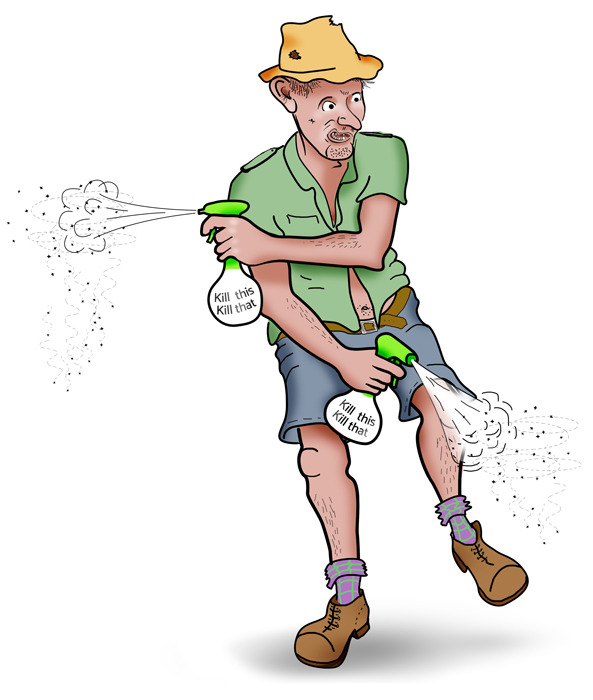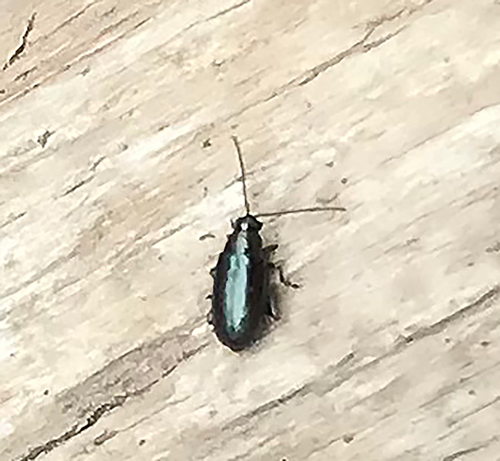Bug Control (Flea beetles)
Whilst I've never been a boy scout, I've always been a believer in preparation when it comes to gardening and as I've noted on some of my other ‘garden pest' blogs its worth planning for pest invasions before spring arrives, in order to give yourself the best chance of avoiding them altogether. Last year I had to deal with a really annoying garden pest that I had been lucky enough not to have had the ‘pleasure' of before.

These pretty dreadful characters go by the names of Phyllotreta and Psylliodes otherwise known as ‘Flea Beetles'. This is a really annoying garden pest for a number of reasons, the main ones being that they can decimate salads crops almost overnight, their movement around crops is rapid, due to being able to reportedly jump up to 30cm in a single bound (not sure which flea Olympics recorded that) and they are somewhat costly to eliminate in small gardens where growing space verses crop rewards is limited.
Flea beetles look like, as the name suggests, flea sized beetles. They are usually about 2mm in length and have a shiny metallic black or dark green appearance. Photography for this blog was a challenge as once discovered they tend to jump away like fleas. However, there are usually hundreds of them present once they get going, so it not usually difficult to detect the problem.

If you experience Flea beetles, the first sign is usually (where salad is concerned) a mysteriously ‘missing crop' because the plants have barely got out of the ground, especially with direct sowing, and they've been eaten or the larvae of the flea beetle has destroyed the root.
On more mature crops they create tiny holes in the plant, which as the plant grows appears like the plant has been ‘peppered' with a shotgun blast. Commercially, on some larger Brassica crops, its often preferable (with I imagine quite a lot of resignation) to let them munch on the outer leaf layers, whilst the inner main crop remains untouched. In a small garden like mine in Essex, where space is at a premium that's not an option. Its also worth noting that Flea beetles have a specific 'life cycle' and during this period they will lay their eggs next to plants on which they feed and the eggs, once hatched into larvae, then feed on the roots of the plants
Insecticides
If on discovery of a flea beetle invasion your first thought is to spray, then there are a number of websites that do suggest using specific insecticides, which are likely to be effective but, in my experience, almost all insecticides take a ‘scorched earth' policy and will kill everything they come into contact with, including beneficial insects, even insecticides that claim to be organic.
This might introduce problems in other areas of the garden that you're also trying to deal with. Flea beetles do have natural predators such as Rove beetles, Lacewing larvae and some predatory wasps. So, I would advocate avoiding chemical control as much as possible.

Organic controls
There are many ways that you can control infestations of flea beetles organically but I've listed below the ones I think work best.
Tidy up areas of debris
Ensure that old leaf litter is removed from your garden particularly under shrubs as flea beetle adults over winter in these areas. I find that this approach helps eliminate other garden pests too. I also, hoe empty vegetable beds during winter to eliminate adult flea beetles that can over winter in soil. Keeping the garden tidy in this way may not be fashionable at the moment as many promote the re-wilding of garden spaces and not being too tidy but around my vegetable beds, I try to ensure a neater garden approach.
Avoid direct sowing
If you can avoid direct sowing and bring on plants in a more controlled environment until they are more mature, the plants might then stand a better chance against flea beetles. Just make sure the controlled environment is also absent of Flea beetles!!
Cover salad crops with fine insect proof mesh.
I've tried this with some success but ensure the bed is prepared as above, because if the beetles or larvae are already in the soil or get through any gaps then you're effectively trapping the problem in with your crops.
Use aromatic plants to discourage flea beetles.
This I feel is one of the best methods of discouraging flea beetles in the first place. Plants such as Nepeta, Sage, Mint and Basil work well. The aromatic leaves of these plants tend to discourage flea beetles. I tried Basil last year which seemed to work well but I'm going to try growing salad crops amongst more of this type of crop in the coming year and include garlic as well.
Use a Diatomaceous top dressing to the area.
I've not used this material yet but Diatomaceous Earth is a mixture of microscopic fossilized aquatic organisms called Diatoms. The skeletal remains of these fossils are made of a high percentage of silica (a mineral used in ceramics and glass). It's very effective when combating pests that have an exoskeleton (That's a creature that has an external skeleton). It works by shredding the exoskeleton and causing the insect to dehydrate and eventually die.
I've read that this works particularly well on flea beetles. There are however a number of considerations when using this material.
Firstly, many insects have exoskeletons and many are beneficial to the garden so limit its use specifically to infested areas.
Secondly, be careful to use some form of mask when spreading this material as its not good to inhale any dust. You will need to reapply the top dressing after any showers as water reduces its effectiveness.
Lastly you should use ‘food grade' Diatomaceous earth on plants. Cost may be an issue here especially where you are only growing a small amount of the crop.
Nematodes
Finally, and often the garden stalwart for pest control, is to use nematodes for flea beetle larvae. As with all nematodes the type should be specific to the pest and for flea beetles I've read Heterorhabitis bacteriophora is the one to use. Be mindful though of the temperature when applying. Nematodes only work when the soil reaches certain temperatures.
So, there are a number of organic methods of controlling Flea beetles without resorting to insecticides and best of luck with all your crops this summer.

